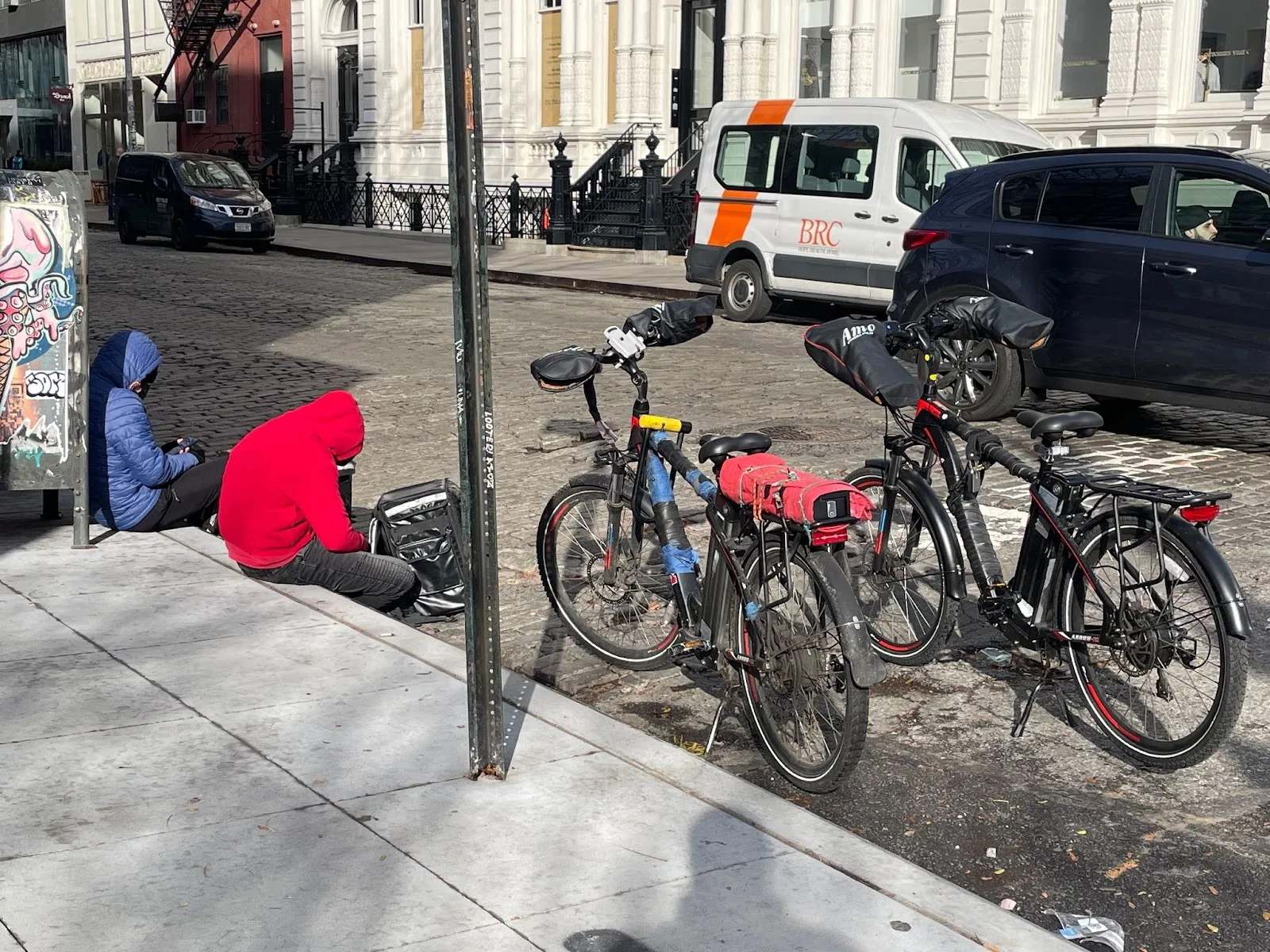Field Note #1: The Pile
December 4, 2023
sounds
birdsong
children screaming and playing
gentle hum of Hvac
cars on 1st ave, seem distant
occasional chatter of arabic at halal truck, unknown african language
flapping of pigeon wings
small birds perch themselves in the trellis of bikes in the pile, like an extension of the tree’s branches
This is a record of the field visit I did to the corner of 1st Ave and E 11th St. I stood in front of the “pile” recording observations of the site between approx 11-11:30 am, but my field notes begin at 10:30am on my walk along Bowery towards the site in the East Village.
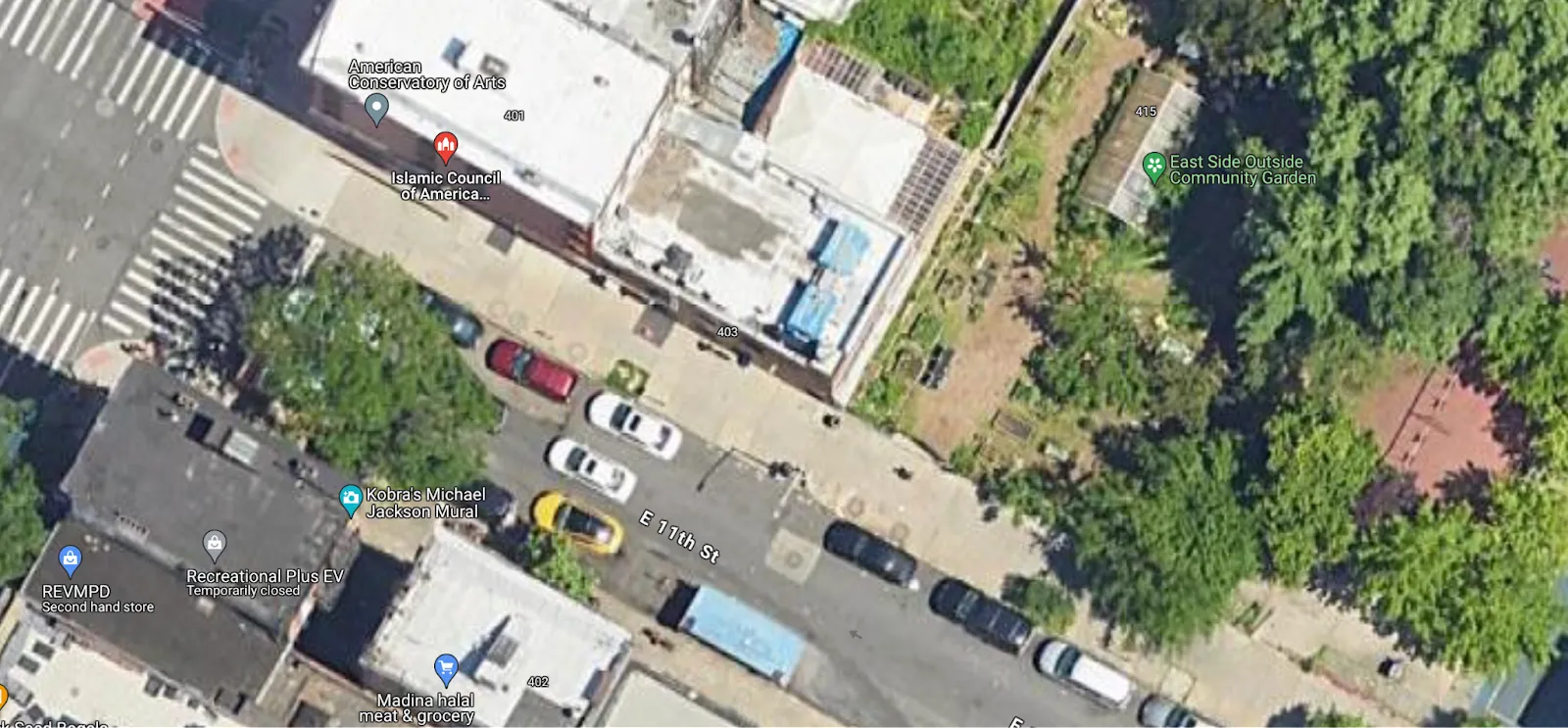
Walk to site
The algorithm is active. Riders wait along the street, seated in silence, shoulder-to-shoulder, their bikes waiting (one assumes, fully charged) ready to take the day's first order. They're bent over their phones. Is it for work or play? Are they scanning the market of possible deliveries to take? Or idly scrolling. At a distance, their screens appear as nothing more than black glass. I snap a photo and keep walking.
Some riders are already on the move. Walking down Bowery, a major North-South thoroughfare, there are wide bike lanes. It doesn't take long before the delivery riders ("riders") begin to zoom past. The first one I see on the move speedily overtakes a cyclist, I assume a commuter, that's pushing a regular (non-electric) citi bike. I think to myself "time is money." The speed of the rider, or specifically, their e-bike, seems to testify this exactly.
Stare up from the streets and the cyclists and the cars there is the densely massed Manhattan cityscape. Look up even further and swelling flocks of pigeons, appearing at a distance like a loosely held blob of flapping wings, undulate in the spaces between the buildings.
Many logistics algorithms are at work today. As I walk towards the East Village, I encounter delivery vehicles, delivery men (all I saw doing this work today appeared to be men) and their various vehicles. Walking down one side street I passed, no more than 30 ft apart, a brown-shirt UPS delivery man pushing a cart stacked high with boxes, and then an Amazon delivery person towing a cart with their characteristic blue-yellow cases.
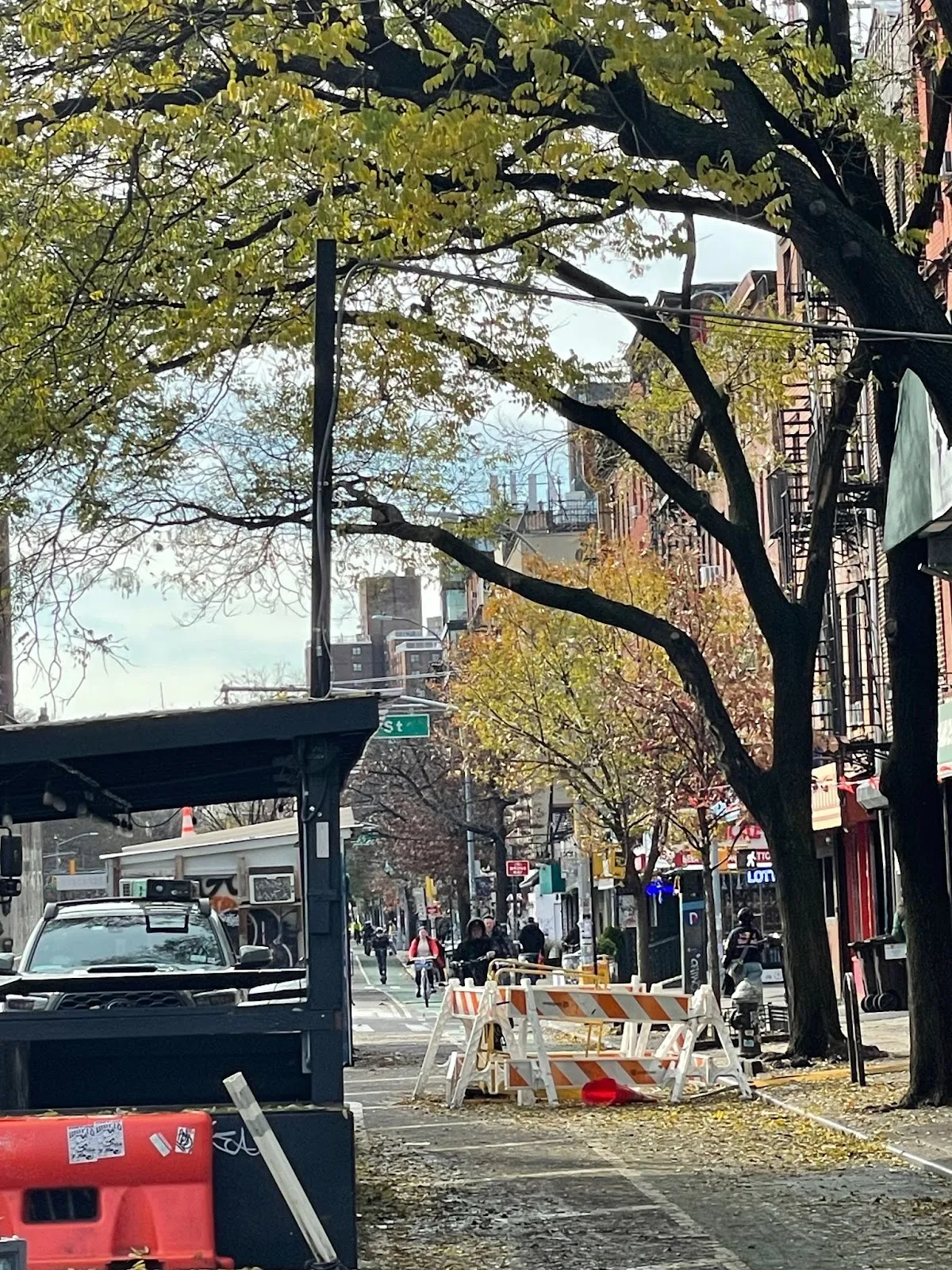
The bike lane on 1st Ave. On this morning, cyclists had to navigate various obstacles.
Reaching 1st Ave, another active north-south thoroughfare, I see many more riders. Some are standing, waiting, right at the edge of the bike lane. Others whizz past, circumnavigating commuter cyclists. With so many riding on this street, I quickly begin to notice variations in their equipment. Some wear helmets, some use hand protectors (and some of these are wrapped in plastic cases or plastic grocery bags), some bikes are mounted above their rear wheel with plastic milk crates, some carry two batteries, and so on.
The variation in accessories is made even more evident walking past rows and rows of delivery e-bikes locked to posts, and to each other, on the edge between the sidewalk and the street. One can readily discern delivery from commuter bikes because there are a certain number of frames that appear to be commonly used for the purpose, in addition to the clear evidence of wear and repair on these working bikes. One frequent feature of the delivery bikes is that their frames are wrapped in colorful tape.
As I walk along the eastern sidewalk of 1st Ave, the rows of parked bikes get denser. I've reached E 11th St, the field site.
At site
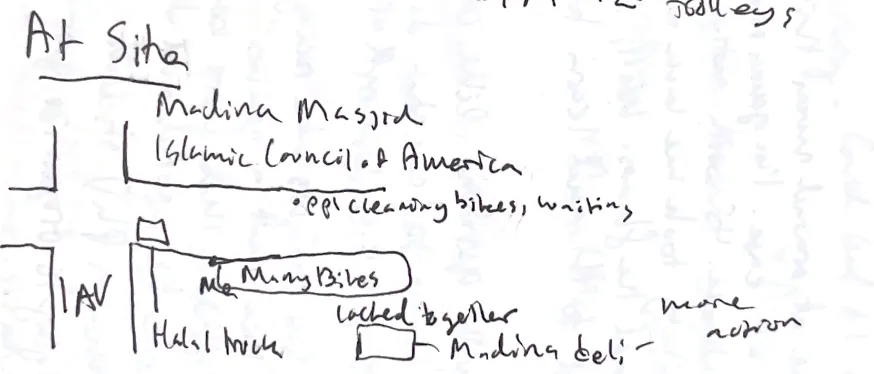
When I first arrive at the field site, I'm surprised to notice how few people and bikes are here compared to previous times I've walked past the field site. One of the reasons I chose this site was that when I sometimes walk home along 1st, around 6:30-7:00 pm, I'll see the entire street filled with e-bikes, people (presumably many of whom ride the parked bikes) and the doors to the Islamic Council of America are open with people streaming in and out. In other words, I had thought of this place as a bustling hub of activity. But today it felt quiet.
I first orient myself to the site. On the north site of the street is a large red building, home to the Madina Masjid Islamic Council of America. On the sidewalk in front of the center are some people. I notice one man is cleaning an e-bike. Some other people are leaning against the wall, or are seated. My first impression is they are "waiting." Further east is a community park.
On the south side of the street, where I am standing, is a large purple Halal truck parked as close to 1st as possible. On the sidewalk is a very large cluster of electric bikes all parked together in a "pile." Between the pile and the street is a relatively large tree that still has many green leaves. Further east still is the Madina Deli. Some men are standing in front of the deli. In front of the deli, on the street, is a large shipping container scrawled in graffiti. Some bikes lean against it, and yet another (less large) thicket of bikes are locked to one another.
I immediately am confused about the politics of locking bikes to one another. As I know from my own cycling experiences, if I lock my bike to someone else's and they don't have my key, then they can't use their bike until I've unlocked mine. So if some parties to the pile are absent (and in this moment, there was a fraction of people to bikes) then what happens? The arrangement felt confusing, improbable, and intriguing. One possibility is that the bikes are owned by a community with a central authority responsible for unlocking the bikes. I can only speculate, but because of the questions it raises, the pile became a focal point for my field visit. I place myself, leaning against a building, directly in front of the pile and continue to observe.
Tuning into my first impressions of the local soundscape, I notice the hum of some machinery parked in the road, upbeat Arabic music emanating from the Halal truck along with the smell of roasting meat. In the backdrop there's the murmur of voices.
I start becoming self aware. It's not my place to linger. I wonder, will someone come up to me? Ask what I'm doing here? Against the backdrop of the Israel-Gaza conflict, is there a feeling of tension in the proximity of the American Council (which seems to function as a mosque)? Is this tension felt? Is my presence felt? Or do I blend into the scenery to those around me? I push past the feelings of discomfort by starting to notice a scene unfolding before me.
Scene 1:
A man wearing a black leather jacket and a black beanie printed "BROOKLYN" in white block font rides past the pile on his e-bike and circles back again. (I wonder if he's looking for a place to park his bike within the tangle of the pile and is scanning for an opportune place.)
He instead parks his bike to the left of me and removes the battery, placing it in the basket of a bike. He proceeds to stand and stare at the men across the street. He doesn't approach them, but paces back and forth. He has a sullen look on his face. His eyes seemed distinctly, almost glisteningly, sad. (I wonder, is he sad? Or is this his resting face?) He appears to be in his early 20s, the other men standing around here appear to be older.
I turn my attention to his bike. It has no accessories, only a dirty red tote hanging from the handle bars. It makes me realize that the accessories probably also a reflection of prosperity (indeed I've seen some very ostentatiously decked-out e-bikes) and, perhaps, how experienced one may be as a rider (to both value the vehicle enough to invest in accessories and have ridden enough to invest back into it. perhaps it also signals ownership of the bike).
We make eye contact. Suddenly he steps into the pile and bends forward, deep into the mess of bikes. I don't catch what he's doing, his action is quick, but I then see him deposit a battery next to a bike that does not have one in its frame.
A new battery suddenly appears on his bike. Did he just do a battery swap? An illicit swap?
As I'm thinking about this a rider passes me on the sidewalk. We lock eyes, and he gives me a quick head nod in acknowledgement.
Not long after, the man with the Brooklyn beanie rides off. He didn't speak to any of the men there and nobody noticed his swap. The only evidence is the bike without a battery, with a battery (one assumes empty) leaning against it deep within the pile.
With him gone, and the nod of acknowledgement from the other rider, I'm starting to relax and feel more at ease standing there, observing the people, the non-humans, and cadence of the place.
The area feels "empty" because it is devoid of people, and yet the pile suggests the latent potential (cf. Keller Easterling's Medium Design) of the bikes. The bikes are built to rapidly move goods, mostly food, around the city rapidly and nimbly in the chaos of the streets. Their potential also lies in their ability to allow access to the money pulsing through this flow. A flow that feeds millions of hungry New Yorkers.
Thus one latent potential of the bike is its ability to participate in this algorithmic economy. Each cyclist becomes an intermediary in a transaction, that of buying a meal. This occurs within tiers of intermediation, after all, there is itself the additional backdrop of the algorithm, which is an intermediary of every stage from the delivery of the menu to the customer to the facilitation of the order, to notification of the rider to pick up, to managing the restaurant gives the right food to the right rider, to the rider reaching its location (which itself touches on navigation, communication between customer and rider, etc). That participation in this sophisticated coordinated activity, and gaining some (assumed) economic benefit from doing so, requires at minimum a bike and a phone, though as we've seen, to truly make it lucrative requires a much greater supporting material and social infrastructure (access to charged batteries, safe storage for the bike, accessories, safe places to rest, affordable food, etc.)
I realize that the bikes themselves, to an extent, are a provocative and physical manifestation of this largely digitized and therefore hidden, but sprawling, sociotechnical system of food delivery. Returning to wondering about the cadence of the place, I start to realize that it would be determined both by the schedule of Muslim prayer at the mosque, but also to the dining rhythms of the city. Where are the riders now? Are they working? Resting?
For if the riders are working, they would not be here. Indeed, it occurs to me, to look at such a dynamic sprawling system as food delivery one can't focus on a single point. If anything, if one wants to see what riders are doing when they're working then this is exactly not the place.
Are these bikes in the pile excess capacity? Second bikes? Are their riders resting? Or are the bikes, waiting to be swapped?
Observation notes of The Pile
Black plastic bags, bright lime green branded "Whizz" bikes. The bikes all lock to each other, how to untangle? The sound of screaming children at the school nearby. Big tree. Nothing locked to it. Leaves and litter. Black heat cases in some baskets. Bikes new, battered, non broken down. Minority have batteries. Pigeons roost above, on the Mosque, ambient runner and walker passes.
Some men gather. Heavy jackets, clean sneakers, some approach with batteries, but some no! They gather and talk to one another. Their language is not English.
One man wearing a red puffy jacket, ski mask, holds 2 phones. He very slowly and carefully prepares his bike to ride and then slowly mounts it. His bike squeaks off as he leaves.
Bike inspection scene: A man in a black jacket and crisp haircut checks out another man's bike. He opens the heat case. Another man looks on. He then goes to his own bike and slowly and deliberately replaces the battery. He slides the battery in behind the seat. Push. lock. snap. pigeons flap.
The fancy bike that was just checked out appears fancy because it has 2 batteries mounted on it. The rider, wearing a big black puffy sports airpod pros. He smiles at the guys as the bike pulls away.
Suddenly, a man steps out of the back of the Halal truck. He tosses a sheet of yellow rice on the pavement. A cloud of pigeons descent at once. They step over each other to feast. Their little tails all stick up in the air. They hardly have a chance to dig in before a walker's dog forces them to scatter. They disperse only to hover a few feet off the ground until the pavement is sane again. Before long the sidewalk is picked clean and the birds are again roosting in the cornices over the windows above the mosque.
Scooter riders appear in the street. A different energy with their thick, bulky helmets with visors.
As these many scenes unfold, I start to recognize a distinct, urban "stillness" to this place. The quietness of the place, and the proximate park, the backdrop sounds of children playing make it seem like a "courtyard" of rest and respite from Manhattan. This quiet street, few cars, familiar food available, where people can idle--it together makes the algorithm's not felt like in the proximate streets, as I experienced on my walk over here.
Another rider pulls off. We briefly lock eyes. He's wearing a grey beanie that says "U.S. Army."
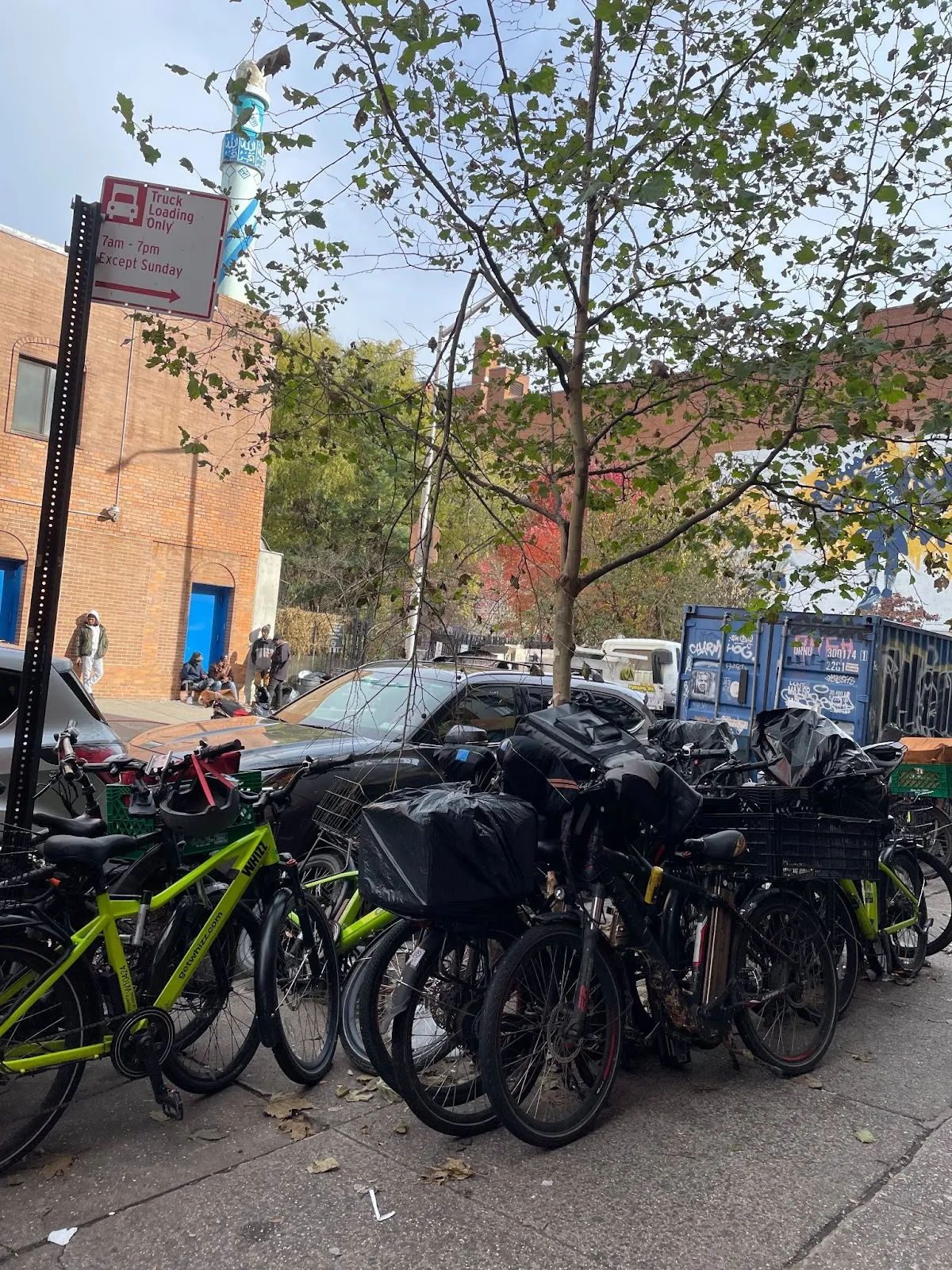
The “pile”. Notice the various accessories on the bikes, the tree in the foreground, the park and school in the background, the minaret, and riders taking a moment of rest in the background.

